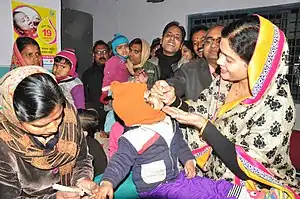Pulse vaccination strategy
The pulse vaccination strategy is a method used to eradicate an epidemic by repeatedly vaccinating a group at risk, over a defined age range, until the spread of the pathogen has been stopped. It is most commonly used during measles and polio epidemics to quickly stop the spread and contain the outbreak.[1][2]

On Pulse Polio Day, a child swallows vaccine drops and is marked as vaccinated (felt-nib pen on finger). The Pulse Polio immunisation campaign eliminated polio from India.
Mathematical model
Where T= time units is a constant fraction p of susceptible subjects vaccinated in a relatively short time. This yields the differential equations for the susceptible and vaccinated subjects as
Further, by setting I = 0, one obtains that the dynamics of the susceptible subjects is given by:[3]
and that the eradication condition is:[4]
See also
- Critical community size
- Epidemic model
- Herd immunity
- Pulse Polio
- Ring vaccination
- Vaccine-naive
References
- Nokes, DJ., Swinton, J. The control of childhood viral infections by pulse vaccination.IMA J Math Appl Med Biol. 1995;12(1):29-53.
- Nokes, DJ., Swinton, J. Vaccination in pulses: a strategy for global eradication of measles and polio?Trends Microbiol. 1997 Jan;5(1):14-9.
- Shulgin, BV., Stone L., Agur, Z. Pulse vaccination strategy in the SIR epidemic model. Bull Math Biol. 1998 Nov;60(6):1123-1148.
- Stone L., Shulgin, B., Agur, Z. Theoretical examination of the pulse vaccination policy in the SIR epidemic model. Mathematical and computer modelling, 2000, 31 (4), 207-215
External links
Wikimedia Commons has media related to Vaccinations.
- Immunisation Immunisation schedule for children in the UK. Published by the UK Department of Health.
- CDC.gov - 'National Immunization Program: leading the way to healthy lives', US Centers for Disease Control (CDC information on vaccinations)
- CDC.gov - Vaccines timeline
- History of Vaccines Medical education site from the College of Physicians of Philadelphia, the oldest medical professional society in the US
- Images of vaccine-preventable diseases
This article is issued from Wikipedia. The text is licensed under Creative Commons - Attribution - Sharealike. Additional terms may apply for the media files.